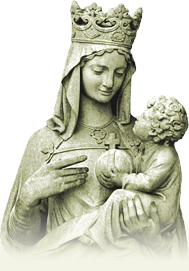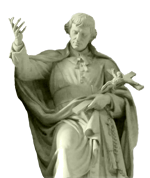Religion
Gnosis: the occult religion in history
Orlando Fedeli
With the fall of communism, what has already manifested itself here and there, was spread throughout all our skeptical twentieth century: there was a great boom of mysticism. Nowadays, conversations are often about horoscopes, tarot, hinduism, homeopathy, alchemy, occultism, esotericism and all types of superstitions widespread. And even atheistic communists began to display the bumper stickers “I believe in gnomes” on their cars.
The phenomenon was so invasive that the famous international magazine 30 Giorni began publishing a series of articles about heretic mysticism and about gnosis. And that which was a subject for a few learned people turned out as a public and universally admitted subject. (1).
Thus, now it is obvious that Simone de Pètrement, after having analyzed post-Romanticism Literature, that is to say, the Literature after the French Revolution, was right when she concluded that: “judging on the basis of our literature, we have entered a gnostic age” (2).
Eric Voegelin, by examining the totalitarian systems of our time – nazism, fascism and communism – concluded that all these were gnostic systems and that the parties which adopted these systems were, in truth, “ersatzs” of religion. He also does not hesitate to say that psychoanalysis and progressivism were cut from the same cloth of the gnosis:
“By gnostic movements, we understand movements like progressivism, positivism, marxism, psychoanalysis, communism, fascism and the national-socialism (nazism)” (3).
There are even those who see in modern science itself reflexes of the ancient gnosis. For example, Jacques Lacarrière calls Einstein, Planck and Heisemberg “ces gnostiques de notre temps” (“those gnostics of our times”) (4).
We do not mean to endorse the conclusions of such a work, however it is interesting to recall Fritjoff Capra’s bestseller – “The Tao of Physics” – which intends to link all modern physics to gnosticism.
We could quote many other authors. For the ends of this article, the facts, these erudites, and the cultural diffusion magazines will suffice.
* * *
When one studies gnosis, one enters a maze full of mist, trying to discover secrets that will allow one to reach a mystery. It is not bewildering that this subject leads to confusion.
It is, therefore, necessary to establish distinctions. And the first one is between pantheism and gnosis. The very “Dictionnaire de Théologie Catholique”, from A. Vacant and E. Mangenot (5), quotes a bunch of pantheistic and gnostic doctrines without distinguishing one from the other. The list goes from Hinduistic, Egyptian, Chinese and Chaldean religions, to both Heraclitus and Parmenides, besides the sufi Ibn Arabi, Campanela, Diderot, Kant, Novalis and the Romantics.
While pantheism is the doctrine that considers that everything – including matter – is God; gnosis, on the contrary, in almost all its systems condemns matter as an evil work of creation.
By somewhat simplifying the problem, whose meanders cannot be examined within the limits of this article, one may say that pantheism represents a quite optimistic trend , while gnosis represents a pessimistic tendency (6).
The gnosis is dualistic, anti-cosmic, and anti-rational. But this is a distinction that in some cases must be attenuated, because some gnostic systems are ambivalent in relation to the material world, which is dialectically loved and hated at the same time (7). On the other hand, there are pantheistic systems that admit the transformation of matter into spirit, at the end of the evolutionary cycle (8).
For example, in the pantheistic system of Plotinus there is a clear tendency towards gnosis, although this neoplatonic author has even written a work against the gnostics of his time.
It would be convenient to say that pantheism is an anti-chamber for gnosis; which is a system reserved for those whose spirits lean more towards proud mysticism rather than towards sensual materialism.
* * *
To form a judgement about gnosis, we may say that it intends to be the “knowledge of the unknowable”.
Evidently, this conception reveals a contradiction that is typical to gnosis. It is a conceptual and logical contradiction to know the unknowable. But it happens that gnosis repels intelligence and logic as being deceptive. The true knowledge would be intuitive, immediate, and not logical and discursive.
Knowing the unknowable, in fact, means giving man full knowledge about God and about the evil, things that are impossible to be understood. We are unable to comprehend or attain knowledge of the essence of God, Who is infinite and transcendent, impossible of being apprehended by our intellect. We also cannot understand evil and sin: the evil as a being does not exist, and moral evil has no reason that justifies itself.
Thus, gnosis intends to offer man a natural knowledge that would put him in position of understanding – and therefore surpassing – God, of understanding evil and, moreover, of knowing man’s own innermost nature, which would be divine.
Gnosis is therefore the religion that offers man the knowledge of good and evil.
Now, it is known that the tree of the forbidden fruit of Eden is exactly the tree of knowledge of good and evil (Gen. II, 10). Thus, gnosis would have been Adam’s temptation. As a matter of fact, the serpent promised our first parents that, if they ate of the forbidden fruit, they would “be as Gods, knowing good and evil.” (Gen. III, 5). Adam and Eve’s temptation was to become gods. This is man’s great temptation that, taken by proud, such as Lucifer, does not admit his finitude, does not accept his contingency.
This temptation is, in fact, an anti-metaphysical revolt. Now this is another way of regarding gnosis: an anti-metaphysical revolt.
If we admit this interpretation of Adam’s temptation, we shall have to conclude that there is a continuity of gnosis in History. And that is what scholars certify: gnosis really presents itself as a religion sometimes occult, sometimes public, yet always maintaining unity and continuity throughout History.
Ladislao Mittner, when studying the Protestant Pietism, a mystic and gnostic sect founded by Spenner and originated from the works of Jacob Boehme, links this sect to a single huge gnostic movement existent in History.
To represent the unity of the gnostic religious phenomenon, Mittner uses the very appropriate and coherent image of the Karsic river.
In the Karsus, a calcareous region in the former Yugoslavia, there are rivers that disappear suddenly into the extremely permeable calcareous ground and then flow underground, only to reappear on the surface many kilometers ahead. A Karsic river is one that appears and disappears, becoming sometimes visible, sometimes hidden along its path.
Mittner says that “it is almost impossible to distinguish pietism from the many other religious sects of the time. Particular veins of the movement display Karsic phenomena: they appear, disappear, and, all the sudden, reappear further ahead, without the identity of the vein being able to be properly demonstrated” (9).
So is the gnosis: in History it is a religious phenomenon of the Karsic type.
Many authors verify this historical unity of gnosis throughout the ages and civilizations. Dennis de Rougemont, for example, wrote:
“Nearer to us than Plato and the druids, a kind of mystic unity of the indo-european world is drawn like unto a filigree in the background of Middle Age heresies. If we embrace the geographical and historical dominion which extends from India to Brittany, we verify that a religion was spread therein, to say the truth, in a subterraneous way, since the third century A.D., syncretizing the set of myths of the Day and the Night just as they had been initially elaborated in Persia, afterwards in the gnostic and orphic secrets and which is the manichaeist faith.” (10)
In his turn, H. I. Marrou testifies:
“(...) indeed, gnosis and its pessimistic duality express one of the most profound tendencies of the human spirit, one of the two or three fundamental options amongst which man must finally choose. Claude Tresmontant demonstrated well the permanency of the gnostic temptation, ceaselessly reappearing under various forms in western thought throughout the course of its history as in the Bogomils and Cathars of the Middle Ages, in Spinoza, Leibniz, Fichte, Schelling, and Hegel. We could continue on with this history beyond the German romanticism up till our own days: the destiny of Simone Weil is particularly very significant; so it was her neo-gnosticism which finally held her at the Church’s door-sill and her legacy was to be found again in the historic work of her friend and disciple Simone de Pétrement” (11).
The subject, besides being mysterious and fascinating, is very popular nowadays. We shall return to it, in order to inform our friendly readers about the mists that engulfed our age after Vatican II and the end of Marxism.
Notes:
(1) cf. . 30 Giorni, Ano VII, feb. 1992, p. 54, article "Luther? Maniqueist Delirium"; year V no. 2, feb. 1990, p. 3. This issue quotes Cardinal de Lubac, for whom the spiritualistic, mystic and gnostic current of masonry prevails in our culture today.
(2) Simone de Pètrement, "Le dualisme chez Platon, les gnostiques et les manichéens", PUF, Paris, 1947, p.347.
(3) Erich Voegelin, "II mito del Mondo Nuovo", Rasconi, Milan, 1976, p.16.
(4) Jacques Lacarrière, "Les Gnostiques", Gallimard, Paris, 1973, p.78.
(5) Paris, Lib. Letourzey et Assé, 1932, verbete Pantheisme.
(6) cf. R.P. Festugère, “La Revèlation d’Hermes Trimegiste”, Lib. Lecoffre J. Gabalda, Paris, 1954, 4 v., especially v. III “Les doctrines de l’âme”, p. 73-83.
(7) cf. Robert M. Grant, “La gnose et les origines chretiènnes”, Seuil, Paris, 1964, p.17.
(8) cf. H.C. Puech, “Position spirituelle et signification de Plotin”, in “Enquête sûr la gnose”, 2 v., Gallimard, Paris, p. 74/75.
(9) L. Mittner, “Storia della Letteratura Tedesca – Dall Pietismo al Romanticismo”, Einandi, Milan, 1964, p. 40.
(10) Dennis de Rougemont, “L’amour et I’Occident”, Plon, Paris, 1939, p. 47.
(11) H. I. Marrou, french preface to the work of R.M. Grant, “La gnose et les origines chretiènnes”, Seuil, Paris, 1964, p.8.
Para citar este texto:
"Gnosis: the occult religion in history"
MONTFORT Associação Cultural
http://www.montfort.org.br/eng/veritas/religiao/gnose/
Online, 01/07/2025 às 00:19:59h








